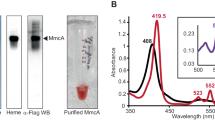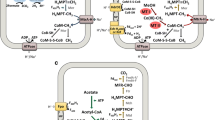Abstract.
Methanogenic archaea of the genus Methanosarcina are able to utilize H2 + CO2, methylated C1 compounds or acetate as energy and carbon source, thereby producing methane as the major end product. The methanogenic pathways lead to the formation of a mixed disulfide derived from coenzyme M and coenzyme B. This disulfide is of major importance for methanogens because it is the terminal electron acceptor of a branched respiratory chain. Molecular hydrogen, reduced coenzyme F420 or reduced ferredoxin are used as electron donors. Four enzymes are involved in the membrane-bound electron transport system of Methanosarcina species, all of which are involved in the generation of an electrochemical proton gradient that is used for ATP synthesis. This review focuses on the membrane-bound electron transport chains of Methanosarcina species with respect to the biochemical and genetic characteristics of the unusual energy transducing enzymes. Furthermore, the review addresses questions concerning the relationship between methanogenic proteins and components of respiratory chains found in bacteria and eukarya.
Similar content being viewed by others
Author information
Authors and Affiliations
Additional information
Received 11 January 2002; received after revision 19 April 2002; accepted 7 May 2002
Rights and permissions
About this article
Cite this article
Deppenmeier, U. Redox-driven proton translocation in methanogenic Archaea. CMLS, Cell. Mol. Life Sci. 59, 1513–1533 (2002). https://doi.org/10.1007/s00018-002-8526-3
Issue Date:
DOI: https://doi.org/10.1007/s00018-002-8526-3




